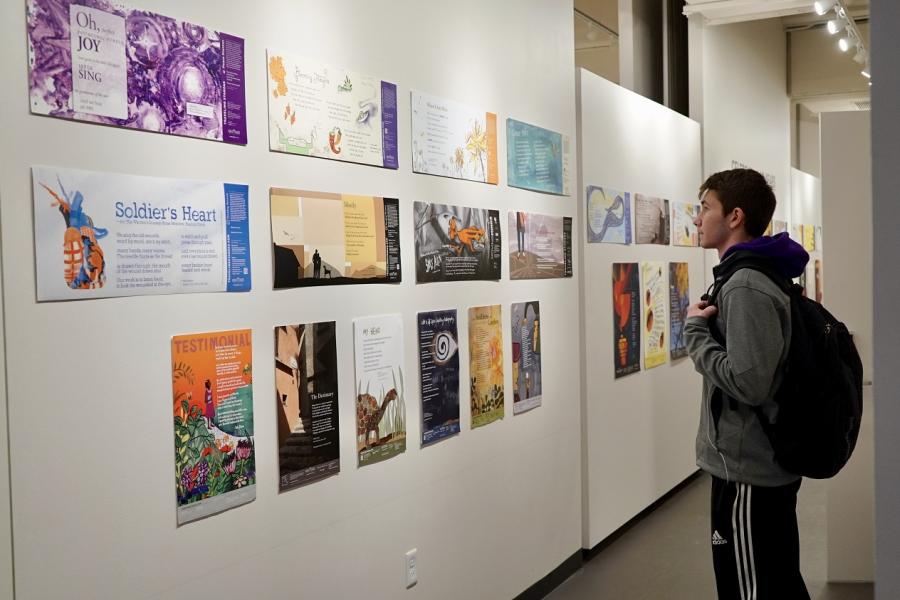Department of Biological Sciences

Kent State Professors Reveal Important Details about the Brain Cells that Control Fertility
Kent State researchers’ innovative techniques have unveiled surprising new details about the brain’s fertility cells that may prove useful for treating infertility disorders. After several years of research, Aleisha Moore, Lique Coolen and Michael Lehman published a paper in the Proceedings of the National Academy of Sciences USA, showing groundbreaking findings identifying which cells in the brain control fertility, as well as revealing an unexpected level of complexity in their control of reproduction.

Health and Well-Being of Students, Faculty and Staff Brought to Light by Healing Stanzas
Students across the nation were challenged as the pandemic swept the world. Healing Stanzas, a collaboration between the Wick Poetry Center, the Healthy Communities Research Institute and the Brain Health Research Institute, seeks to combine the science of brain health and public health with the creative energy of the humanities to provide Kent State students, staff and faculty with an opportunity to improve wellness through reflective poetry.

Kent State Graduate and Undergraduate Research Mentorship Awards Announced
Intentionality to build successful academic mentoring relationships with students is what sets professors apart at Kent State, and each year two professors at the graduate and undergraduate level receive a student-nominated award for their ability to do so. The intent of the award is to recognize those professors exceeding in mentoring students in how to perform research in any field.

From Student to Researcher: SURE Program 2021 Student Spotlight
As once stated by educational Pioneer and famous American Philosopher John Dewey, all that we learn is derived from experience. Kent State continues to foster innovation and promote the development of hands-on learning through various collaborative efforts focused on building experience and training. Among the opportunities offered through the university, the Summer Undergraduate Research Experience (SURE) Program provides undergraduate students with the chance to engage in an intensive research project during the summer break.

Researchers Take a Closer Look at Nitrogen in the Chihuahuan Desert, New Mexico
Researchers from Kent State University and the University of New Mexico determined how nitrogen-fixing plants and soil microbes contribute to the overall nitrogen availability in the Chihuahuan desert in New Mexico.

Lighting a fire(fly): Biological Sciences Researcher Helps Teachers Get Messy with Data
Julia Perrone, research technician and lab manager of the Bahlai computational ecology lab in the Kent State Department of Biological Sciences, wants teachers and students to get a chance to understand ecology and data science from a hands-on perspective. Perrone, a recent graduate of Kent State’s M…
Patterns, Populations And Podcasts: Computational Ecologist Receives Prestigious Early-Career Award from NSF
Recent funding from the National Science Foundation (NSF) has given interdisciplinary researchers the opportunity to help drive our understanding of patterns in nature when bringing together big data sources collected in different ways. The NSF awarded Christie Bahlai, Ph.D., assistant professor in…Excellence in Undergraduate and Graduate Research Mentorship Awards
From Kent State University's Division of Research & Economic Development Kent State University is pleased to announce the two winners of both the Excellence in Undergraduate Research Mentorship Award and Excellence in Graduate Research Mentorship Award. As part of the nomi…
Kent State Receives More Than $3 Million In Grants From National Science Foundation
Kent State University has recently received a flurry of grants totaling more than $3 million in funding from the National Science Foundation (NSF), which will support research and innovation in a wide range of fields within the College of Arts and Sciences.

Honors College Student Studies Abandoned Mines in Cuyahoga Valley
Michael Back is a graduating senior Honors College student, majoring in biology with a concentration in organismal biology and a minor in Spanish. Originally from Sharon Center, Ohio, Michael has been interested in ecological restoration since he was in high school. Now in the final semester of his Senior Honors Thesis, Michael used his thesis to delve deeper into his ecological interests. His thesis analyzes a new restoration technique for abandoned surface mines in Cuyahoga Valley, examining “soil bulk density and soil chemistry.”